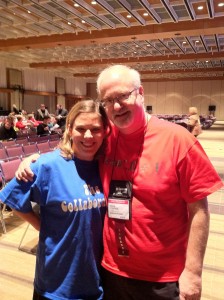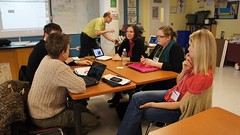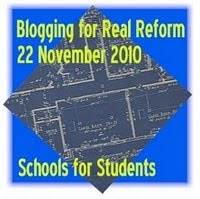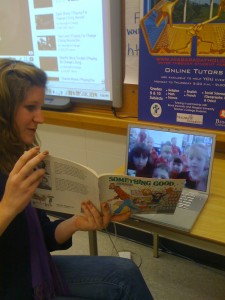
NECC Brings a New Meaning to Social Networking
By: Zoe Branigan-Pipe, Hamilton Wentworth District School Board, Ontario, Canada
On July 1, I left Washington D.C headed for home. The NECC conference was over and it was time to sort it all out. When the airport shuttle picked me up, there was only one other passenger, also headed for the Baltimore Airport, Dr. James Bower.
James Bower – a well renowned scientist, writer, teacher, visionary and academic was sharing a ride with me. I found myself sitting beside Mr.Bower and with ease we found ourselves heavily in conversation, which continued over breakfast at the airport.
It was this meeting that helped me understand what I took from the National Education Computing Conference (NECC). First, is the sheer importance of networking, whether it be face to face, or virtually. It is a given that it is the PEOPLE, not necessarily the ‘technology’ that we need to focus on in order to embrace change and transformation in education. This is how it has always been. People are the tool. Technology is the means – or is it the other way around? It always has been a combination of both. In every sense, history has told us this. Second, that we as Educators have a responsibility to use the tools we have to fuel our students imaginations. We must provide the opportunity for these kids to learn in a variety of approaches and we must do this by teaching kids to problem solve, to think and to seek out their own learning. This is what the NECC was about.
Malcolm Gladwell, (NECC Keynote) describes a “Tipping Point” as “a place, or moment in time of great sensitivity – a place where suddenly, the line on the graph turns upward”. For me, the NECC provided that moment. It would be presumptuous of me to say that I have found my Tipping Point, but I can say that after my experience at NECC, I am back at ground Zero, only upward to go. I met true connectors. I met innovators and researchers who opened my eyes to the effects of what perseverance and determination can have when implementing change. I met educators that have made a difference in their classrooms – a difference that has rippled across classrooms around the world. I became more aware than ever that a lot of change is possible, from the bottom up. In his book, Tipping Point, Malcolm Gladwell gives many examples of how ordinary people have induced world wide epidemics – change that is contagious, that sticks. “People that made small change in their attitudes and behaviours”, he emphasizes.
At NECC, I met these people. Like these people, I am an educator that believes that we need to embrace change, embrace new possibilities – allow a new generation to guide their (and our) learning, teaching and exploration. As spoken by Gladwell, “change is possible, people can transform their behaviour or beliefs in the face of the right kind of impetus.” Is participating in social networks the right kind of impetus? Has the World Wide Web provided the impetus for bringing like minded groups together and the context for a social epidemic? It is my intention in this article to prove that it has.
Many months before the conference, I began developing a vast network of people from all over the world. This learning network was not instant, nor was it easy. It took time, effort, and hours of sorting and reading through profiles and blogs. I learned that if I shared a resource, article, or tool, that it would be reciprocated and instead of coming from just one person, the sharing would come from as many as I choose. With Twitter as my primary platform for sharing globally, I found myself in a Professional Learning Community with a support group that stemmed from Australia, England, all over the United States and Canada. Because of common interests, of education and the changing nature of technology, many of these people joined me at NECC.
I talked with Dr. Bower over breakfast for a couple of hours. He is a patient, kind man and extremely humble. He was genuinely interested in what an elementary school teacher in Ontario would be doing at NECC. He shared with me his lifelong passion for educational reform and how he became the founder, chairman and CEA of Numedeon Inc., and producer of Whyville.com – an interactive, problem solving, project based internet site which has a similar platform to Second Life. Children can enter this site for free and participate in a variety of activities. Hundreds of schools across Texas, and across the world use this platform to help children confront ‘real’ problems, in a safe place.
This brings me to my first session at NECC- The Constructivist Consortium at Sidewall Friends school with Dr. Gary Stager (visionary, author and expert on constructivism in education) and author Peter Reynolds (a Canadian, famous for his book ‘Ish’ and ‘Northern Lights’). I used my ‘Tweet Grid’ a platform that allows real time communication using hash tags (ie.,#necc2009) so that I could converse with people also participating in the session and also include people wishing to attend virtually. The hash tag for this particular session was – #ccdc09. Anyone can still look up this tag to see what was discussed during the presentation. Members of this group learning group used the notes from Tweet Grid to produce a “shared” Google Document. It did not take long before I realized that many of “my people” from my Global Learning Communities (GLC) were in the room as well -Physically in the room!
 First, Jenny Ashby from Australia approached me – “I know you from Twitter” and she hugged me, telling me what a pleasure it was to meet as she had been following my classroom activities and posts for the past school year. It was a humbling experience that she knew about my ‘Flat Classroom’ endeavors and partnerships with other classrooms and schools. As I introduced her to my associates from the HWDSB (Hamilton, ON), she told us about her IPod touch 1:1 program (with students from a K-8 School). She talked how this project – based on successful evidence, is beginning to be replicated in other classrooms and schools across Australia. The information and resources provided from Jenny were invaluable. This one meeting, with Jenny, completely changed my view of Social Networking in my profession. In the past, I networked casually – I shared, they shared. My co-workers, my principal and other colleagues did not see “Twitter” as a serious form of professional development and thus, their participation was limited. Jenny changed that. Imagine – Teachers, across the world creating innovative programs together.
First, Jenny Ashby from Australia approached me – “I know you from Twitter” and she hugged me, telling me what a pleasure it was to meet as she had been following my classroom activities and posts for the past school year. It was a humbling experience that she knew about my ‘Flat Classroom’ endeavors and partnerships with other classrooms and schools. As I introduced her to my associates from the HWDSB (Hamilton, ON), she told us about her IPod touch 1:1 program (with students from a K-8 School). She talked how this project – based on successful evidence, is beginning to be replicated in other classrooms and schools across Australia. The information and resources provided from Jenny were invaluable. This one meeting, with Jenny, completely changed my view of Social Networking in my profession. In the past, I networked casually – I shared, they shared. My co-workers, my principal and other colleagues did not see “Twitter” as a serious form of professional development and thus, their participation was limited. Jenny changed that. Imagine – Teachers, across the world creating innovative programs together.
As the day progressed, and the session discussions continued about the context and elements of project based learning, I discovered that Wes Fryer and Chris Champion were sitting across the room from me. These highly acclaimed educators, from Pennsylvania and Oklahoma, were two the most valuable contributors to my GLC. My principal (William Demille) and I had a fascinating discussion with @Chris Champion (Twitter name) who told us of a school in Montréal, similar to that of Lawfield, where the vision and direction of the school came from an innovative administrator and similarly, was in its own silo of educational transformation within the District. As I had been following (silently) the blogs of @Wes Fryer (author of Moving at the Speed of Creativity), I became completely thrilled when he introduced me Dr. Scott McLeod –the creator of the famous UTube video, “Shift Happens”. I was registered for his event in two days. An event that would bring educational leaders together and policy makers to talk about the process of transformation in schools today.I follow him on Twitter. That day, he began following me.
My point is that each one of the connections that I made that day was authentic and “stuck”. Each person that I spoke to gave me something valuable – Jenny sparked an interested in an Ipod Touch Program – perhaps my next project. Chris Champion provided valuable information to look at a possible partnership with a “like minded” school in Ontario. Gary Stagler challenged me to identify the elements of good project based learning – learning that is personally meaningful, connects disciplines and people. Interesting – since that was how I was learning that day. “ It’s about knowledge construction, not reproduction” he emphasized.
It was appropriate that the session ended in a conversation with Canadian author Peter Reynolds. His presentation did not focus on technology. He talked about how educators –our attitudes, our actions, and our beliefs can affect children in even the smallest ways. Reynolds emphasized the importance in letting children feel secure and safe, to allow them to find their OWN possibilities. He talked about his “blank book”, the one that has no words, no cover. Just blank pages. “It could be YOUR place”, he emphasized. “It is all about possibilities”. A quote worth repeating – “Change is possible, people can transform their behaviour or beliefs in the face of the right kind of impetus.”
Possibilities were what Dr.Bower and I spoke about that day. The possibilities of finding innovative ways to help children experience the world around us – in complex, and personally meaningful contexts. Dr. Bower discussed the importance of authenticity and made me question whether the context is authentic or the work authentic that makes for meaningful learning.
The conference itself was an extraordinary mish-mash of events, workshops and displays demonstrating the most current and valuable resources for the education industry today. The possibilities were quite literally, endless. It would be impossible to see the entire exhibition. While I would commend those who did, I question how much time they gave themselves for authentic conversations, to meet people and to talk and converse with our Educational Innovators. The context of NECC was the people.

In his book “Tipping Point”, Malcolm Gladwell, talks about three types of people: Connectors, Mavens and Salesman. These people, he says, are essential in making “change” happen and stick. Another member of my GLC, Robert Martellacci, founder of the Mindshare Report , according to Gladwell would be a Connector (with a little Maven and a little Salesman in him as well). His motivation, enthusiasm and his overall optimistic, self assured presence attracts people. His booth at NECC was not elaborate. He did not have a product to show. He did not display any “new” innovative equipment. However, his booth was always crowded and there was always good conversation going on. Why? According to Gladwell, his job is one of the most important in making change happen, and in this case, it is the change that his happening in education that he has become a central messenger. He connects people.
It was Robert that organized the event at the Canadian Embassy in Washington DC. This event would bring together Teachers, Consultants, District Leaders, Production Innovators, Entrepreneurs, and Government Officials. At the event, I was thrilled to speak to the creator and co- founder of ‘Smartboard’ -Nancy Knowlton. Talking to her in 1:1 certainly gave me a new perspective about how and why the “Smart” company has become what it is today. She seemed passionate about the product and its role in education today. I cannot say when her company reached its Tipping Point – but it did. “I was close to bankruptcy” . In our first year, we sold less than 400 Smartboards. We were advised to claim bankruptcy by our accountant. I knew, in my heart that this product would stick. Today, selling 400 Smartboards in one morning would be a bad day of sales.” She told us. “One day, classrooms across North America will have three or more Smartboards in them. It is hands on, current and what students want and need”.
 This would also be the event where I would again, meet some of my most respected GLC members. Kent Manning (@KentManning), an Educational Consultant for the Hastings Prince Edward District School Board in Belleville, Ontario, has been a huge innovator in bringing research based programs centering around Boys and Literacy Programs. I first “Twittered” him when I read a blog that he wrote about his experience watching his son participate as an actor in the play, “The Lion, Witch and Wardrobe”. His son played the part of Edmond. For me, this meant something because I too had the opportunity to be part of the same dramatization a couple of years ago, as the Director. This being, most definitely, my most memorable experience as a teacher. Edmond was my favourite character. Perhaps it was this “personal” connection that intrigued me at first about Kent. I saw him speak at a conference about a year ago. His excitement about podcasting stuck with me. Since, I have created hundreds of podcasts and used this as a tool in my classroom for students with strengths in oral language or as a method of differentiating products and assessments and I have presented several times on the topic. Kent’s enthusiasm and sheer humbleness about publishing his podcasts on ITunes gave me confidence to do the same. What I learned upon meeting him, is that Kent Manning is an extremely passionate educator. He talks about his job as an educator as if it were a hobby. “It is fun to connect people in my district the new and innovative tools. I go from school to school and provide guidance and expertise to teachers and students. I get to see projects grow and develop. I get to make a difference. I have the best job”. His charm, optimism and attitude were contagious. With this one face-to-face meeting, I can’t help feel that he is one of my good friends. I believe that Malcolm Caldwell would consider him to be a Connector. Never before I have learned so much about a person, after just one meeting.
This would also be the event where I would again, meet some of my most respected GLC members. Kent Manning (@KentManning), an Educational Consultant for the Hastings Prince Edward District School Board in Belleville, Ontario, has been a huge innovator in bringing research based programs centering around Boys and Literacy Programs. I first “Twittered” him when I read a blog that he wrote about his experience watching his son participate as an actor in the play, “The Lion, Witch and Wardrobe”. His son played the part of Edmond. For me, this meant something because I too had the opportunity to be part of the same dramatization a couple of years ago, as the Director. This being, most definitely, my most memorable experience as a teacher. Edmond was my favourite character. Perhaps it was this “personal” connection that intrigued me at first about Kent. I saw him speak at a conference about a year ago. His excitement about podcasting stuck with me. Since, I have created hundreds of podcasts and used this as a tool in my classroom for students with strengths in oral language or as a method of differentiating products and assessments and I have presented several times on the topic. Kent’s enthusiasm and sheer humbleness about publishing his podcasts on ITunes gave me confidence to do the same. What I learned upon meeting him, is that Kent Manning is an extremely passionate educator. He talks about his job as an educator as if it were a hobby. “It is fun to connect people in my district the new and innovative tools. I go from school to school and provide guidance and expertise to teachers and students. I get to see projects grow and develop. I get to make a difference. I have the best job”. His charm, optimism and attitude were contagious. With this one face-to-face meeting, I can’t help feel that he is one of my good friends. I believe that Malcolm Caldwell would consider him to be a Connector. Never before I have learned so much about a person, after just one meeting.
It is clear, according to Gladwell, that connectors like Robert or Kent are only one part of starting a social epidemic movement such as innovation in Education. Connectors help us connect to people but “there are also people we rely upon to connect us with new information”(Tipping Poing, pg 36). Doug Peterson also attended the Event at the Canadian Embassy. I have been reading his blog loyally for about a year. Although I have never met him before, he has helped me start my own blog, begin using Google docs and Wikispaces in the classroom, and is usually the first to answer when I have a question, from the smallest details of keyboard shortcuts, to providing relevant articles and current information about education and technology driven standards. Doug Peterson is a Technology Consultant for the Greater Essex County District School Board in Southwestern Ontario. He does not connect people to people. He does however; connect people to new and relevant information. He ensures that he has the latest software updates, and then reports to his GLC the pros and cons of the updates and blogs about his opinions and experiences. He does not do this for personal or monitary gain. He does this because he truly cares about people and has a genuine interest in how and what teachers are using technology and innovation in their classrooms and schools. I would consider Doug Peterson to be a Maven. “A Maven is a person who has information on a lot of different products or prices, or places. This person likes to initiate discussions with consumers and respond to requests.” (The Tipping Point, pg.62). It was a true pleasure to meet Doug. He was not talkative and yet was extremely attentive to other people. He came across very intelligent but was not arrogant. We had a laugh, when telling the story about the time that Doug read a Twitter Post of mine with an attached picture. Unbeknown to me, I had my GPS locater in the “on” position which meant that every time I posted anything, my location could be found. Doug messaged me several times until I took this function ‘off’. While he did not know me, he was concerned of my safety.
As I told Dr. Bower these stories over breakfast, my own reflections of the kind of educator that I am began to make more sense. I am working at a cutting edge school with other educators like myself, wanting to try new approaches to teaching, approaches that are better suited for kids today. I often feel that ‘spreading the word’ is an impossible mission when there are so many other initiatives put out through Ministry Directives. Yet still, NECC surrounded me with people from Coast to Coast who, in there own small ways are contributing to this social education epidemic. Social networking tools, like Twitter or Edublogger, or Skype are just beginning to be recognized in school Districts across Ontario – and the World. Differentiated Products are now being considered ‘sound’ pedagogical practices and thus, more students are being given opportunities to use podcasting, blogging, co-writing through wikispaces, emailing, video conferencing and even micro-blogging platforms to ‘demonstrate’ learning. Classrooms and schools are beginning to experiment with IPod touch programs and 1:1 Notebook initiatives. These gains that we have made, while still small gains, were made NOT because of ordinary people, in ordinary classrooms taking risks, spreading information, and connecting to each other – there is nothing ORDINARY about the kinds of people that are networking these changes. Each person that I have mentioned has become and IS an integral part of my professional learning community. I am privileged that I can honestly say that I have “people” from coast to coast, that hold similar beliefs about education. – People that have tried innovative strategies and techniques in their classrooms and schools -People that I can learn from.
There is nothing ORIDINARY about Dr. Bower and myself, complete strangers meeting over breakfast at a strange airport in Baltimore to talk about Education and our responses to its changing nature. The opportunity to talk and listen to a true pioneer of education reform was indeed the highlight of NECC for me. For over 30 years, Dr Bower has suggested that children need exposure to engaging educational activities. He launched Whyville.net because he believes that traditional teaching methods are not reaching all children and that we, as educators need to grasp and accept a more inquiry-based approach to teaching, particularly using on-line tools that can “fuel kids’ imagination and desire to learn’.
The last evening of NECC, I met with my local people (Hamilton Wentworth District School Board) at a pub, near the city centre. It was here that we debriefed, talked, shared, and strategized about what comes next for our students in Hamilton, Ontario. Here, one week after the last day of school a group of educators, principals, consultants and Superintent of Education met to combine not only our ideas, but the idea’s for each of our Global Learning Community.
For Further Reading/Resources:
Tipping Point, by Malcolm Gladwell: http://www.gladwell.com/tippingpoint/index.html
ISTE: http://www.iste.org/
NECC: http://center.uoregon.edu/ISTE/2010/
Whyville.com: http://www.whyville.net/smmk/nice
Twitter: http://twitter.com
Blogger: https://www.blogger.com
Dr. Scott McLeod: http://www.scottmcleod.net/
Smart Products: http://smarttech.com/
Mindshare Learning Report: http://www.mindsharelearning.com/
Hamilton Wentworth District School Board: http://www.hwdsb.on.ca
More Information about author:
Zoe Branigan-Pipe
Lawfield Elementary School
Tel: 905 387-0062 ext 213
Website: http://fcinternet.hwdsb.on.ca/~zoe.branigan-pipe
Twitter: http://twitter.com/zbpipe
Blog: http://pipedreams-pipedreams.blogspot.com
delicious: http://delicious.com/zoebraniganpipe
Email: zoe.branigan-pipe@hwdsb.on.ca
 A couple of weeks ago, I had the opportunity to spend some time with Doug Peterson (AKA @dougpete, AKA yoda <my master>) in Windsor, Ontario. It may have appeared that the purpose of the visit was to ‘Faceoff at Maxwell School”. But the real purpose was to connect face to face with a colleague and friend that has truly impacted my professional growth by inspiring and teaching me to think outside the box and challenge me in so many ways –to be authentic, creative and innovating in my teaching and learning.
A couple of weeks ago, I had the opportunity to spend some time with Doug Peterson (AKA @dougpete, AKA yoda <my master>) in Windsor, Ontario. It may have appeared that the purpose of the visit was to ‘Faceoff at Maxwell School”. But the real purpose was to connect face to face with a colleague and friend that has truly impacted my professional growth by inspiring and teaching me to think outside the box and challenge me in so many ways –to be authentic, creative and innovating in my teaching and learning.





 In September, my teaching assignment changed drastically – from teaching 12 year olds in a Grade Six Class
In September, my teaching assignment changed drastically – from teaching 12 year olds in a Grade Six Class 